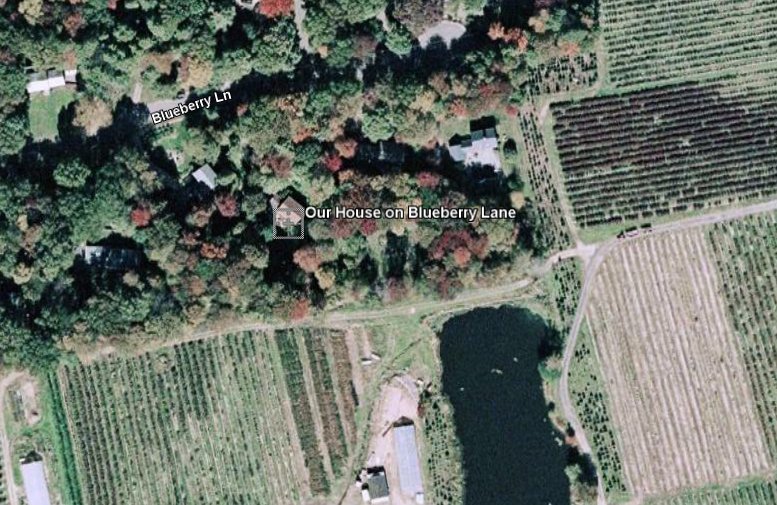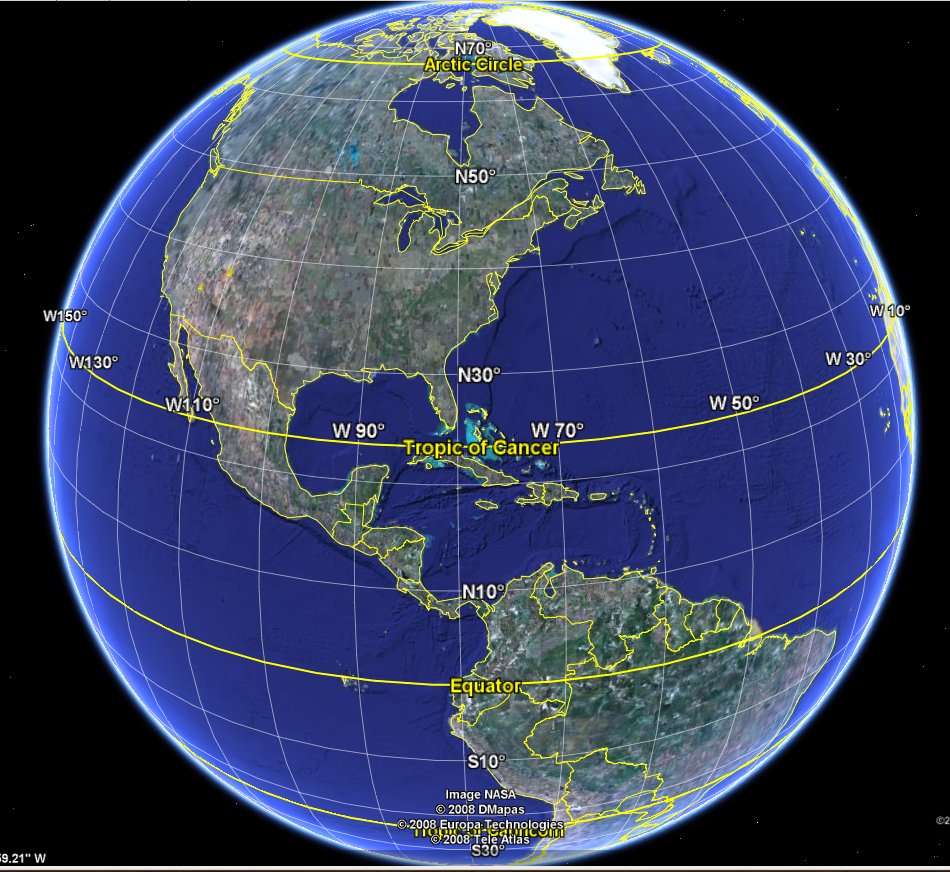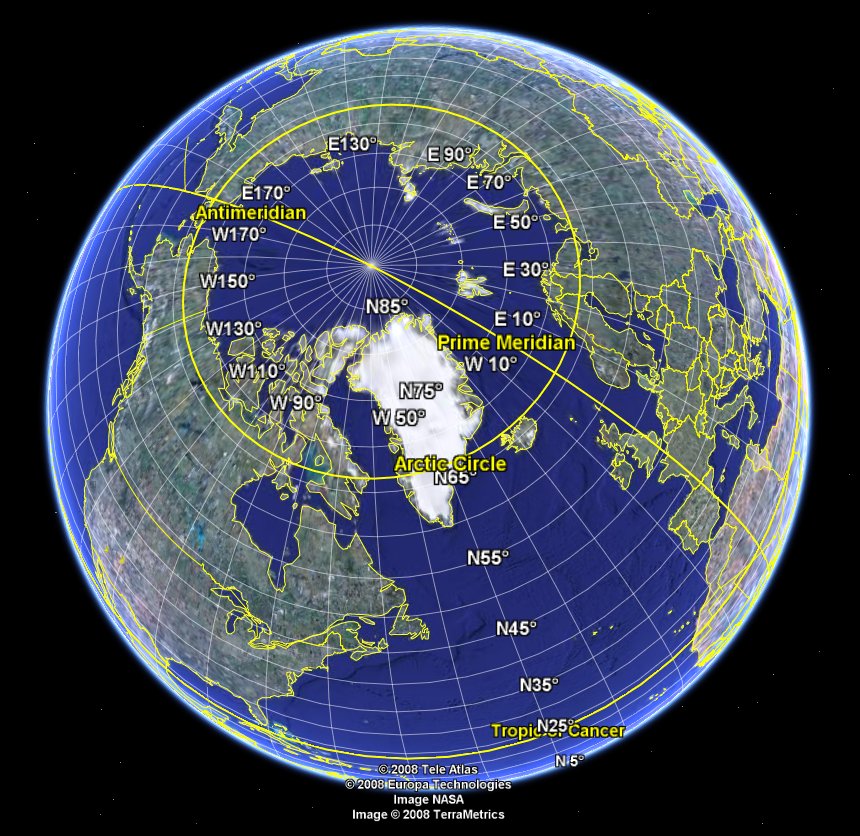Latitude and Longitude
 The house we are renting on Blueberry Lane is located at 41°39’29.20″N latitude, 72°34’45.10″W longitude. If you are curious, you can see our house on Google Maps. When I was working at NASA-Jet Propulsion Labs, I hung out with a lot of mapping people, geographers and cartographers mostly, to whom Geography mattered. In this little note I’d like to explore that notion a bit.
The house we are renting on Blueberry Lane is located at 41°39’29.20″N latitude, 72°34’45.10″W longitude. If you are curious, you can see our house on Google Maps. When I was working at NASA-Jet Propulsion Labs, I hung out with a lot of mapping people, geographers and cartographers mostly, to whom Geography mattered. In this little note I’d like to explore that notion a bit.
When I was a kid I was never able to sort out which was which until one clever friend (let’s give him credit: Jim Conolly) suggested the mnemonic “latitude is flatitude”. So, the latitude lines run horizontally, east-west, and represent how close you are to the equator (at 0 degrees), or the poles (at 90 degrees) respectively. For sailors, this was alway the easy one to figure out when you were lost at sea, because the further north you were, the lower the noontime Sun sat over the horizon. At nighttime, you could “shoot the stars” with a sextant and measure how high Orion or Polaris or some other star rose in the sky. Our current latitude is 41°39’29.20″N, the N meaning North of the equator.
That’s pretty darn far north. It puts us almost halfway between the Tropic of Cancer (below which the noontime Sun will appear straight overhead) and the Arctic circle (above which the noontime sun may not even come above the horizon). I wasn’t quite sure how North that really was though, until I got out a map and checked to see where I would be at that latitude if I were over in California. It turns out that would be around Yreka, which is about seventy miles north of Redding (where my older brother Keith and his wife Cindy reside), and just 30 minutes away from the Oregon border.
What does all this mean in daily life? Mostly, its about daylight and how much of it you get. If you were down at the equator, for example, no matter what season, the sun is up for about 12 hours a day and usually goes somewhere straight overhead. At the poles, on the other hand, during the winter the sun doesn’t come up at all, while during the summer it may stay up 24/7, and simply circle around you, just above the horizon like an hour hand. In our case, deep in November, it means when I get up at 5:45am to make coffee, I am feeling my way through pitch black. The sun finally comes up around 7, but by 3pm it is already twilight. When we lived out in Los Angeles, Gigi and I would go for a walk every day, along the beach, in bright sunlight. Up here, we still go for walks through the trails in the backwoods and farmland, but broad sunlight? Not so much. I’m thinking of taking vitamin D supplements just to make up for what my skin would otherwise produce.
Longitude is all about clock-time. While even the ancient Greeks knew how to determine latitude, the problem of reliably finding your longitude was not solved until recently, when really accurate clocks could be made. The real problem was, unlike latitude, one longitude line (meridian) was just like any other. There was nothing you could look at in the sky to tell you your longitude. So, they had to just arbitrarily pick one (which happened to pass through an observatory in Greenwich, England), and then measure all the other ones with respect to that one, which is called the Prime Meridan.
Not everybody agreed on where “Zero” longitude should be. The French, for example, did not think that Greenwich England was a suitable location, and so they (of course) chose a place near Paris for their “Zero.” This had some serious consequences back when they began building the “Chunnel” tunnel underneath the English Channel, linking England up to France. Each side began digging their end of the tunnel from their coastline towards the other, and had agreed beforehand where (in latitude/longitude) they would meet in the middle of the channel. A few years past, and as the two digging projects began to approach they realized that they were off by about 5 feet in the east-west direction. Apparently the French used the Paris-based longitude system, which they only now discovered did not agree with the British one. Fortunately, they were able to “jog” their tunnels a bit at the end so they joined up.
Our longitude is 72°34’45.10″W, the W meaning West of Greenwich. Our old house in Long Beach was at 118°W, three time zones away. This means that when I come downstairs and sit t my computer at 8am, it is still 5am in California. And that in turn means I have about two hours when I can work on my writing, noodle around on Yahoo or Google, and have breakfast before anyone even thinks about showing up at the L.A. Office. Typically, I start work at 10am EST (Eastern Time), and work until 6pm EST, which is around 3pm on the west coast. Of course, due to the effect of latitude, the sun has already been down for over an hour, and so I end my work day with pitch blackness outside my window. To get some walking done, Gigi and I usually try to get out around 3pm, which works out well for the L.A folks, because it is lunchtime there.
Latitude and Longitude. Just numbers. Numbers that pin your life down on the fragile surface of a blue marble spinning in an elliptical orbit at 18 miles a second around a small yellow star in the minor arm of a barred spiral galaxy that completes just one rotation every 250,000 years around a black hole with a mass of a hundred thousand suns, the whole nebulous pinwheel hurtling towards an unavoidable collision in two billion years with the Andromeda galaxy. Numbers that tell you when to get up in the morning, when you should go out for a walk with your wife through the backwoods, and how much snow will be on the ground when you look through the frosted windows of a New England house as you sip on spiced apple cider on Christmas morning.



Just remember that you’re standing on a planet that’s evolving
And revolving at nine hundred miles an hour,
That’s orbiting at nineteen miles a second, so it’s reckoned,
A sun that is the source of all our power.
The sun and you and me and all the stars that we can see
Are moving at a million miles a day
In an outer spiral arm, at forty thousand miles an hour,
Of the galaxy we call the ‘Milky Way’.
Our galaxy itself contains a hundred billion stars.
It’s a hundred thousand light years side to side.
It bulges in the middle, sixteen thousand light years thick,
But out by us, it’s just three thousand light years wide.
We’re thirty thousand light years from galactic central point.
We go ’round every two hundred million years,
And our galaxy is only one of millions of billions
In this amazing and expanding universe.
The universe itself keeps on expanding and expanding
In all of the directions it can whizz
As fast as it can go, at the speed of light, you know,
Twelve million miles a minute, and that’s the fastest speed there is.
So remember, when you’re feeling very small and insecure,
How amazingly unlikely is your birth,
And pray that there’s intelligent life somewhere up in space,
‘Cause there’s bugger all down here on Earth.